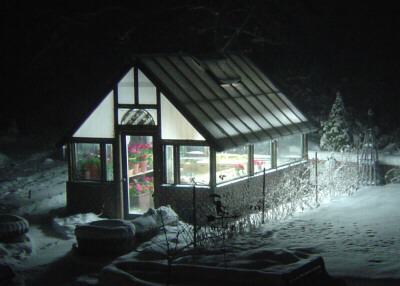
You Should Judge a Greenhouse by its Cover -- Your Plants Will!
Summary: Explore the pros and cons of various greenhouse covering choices as well as greenhouse paneling features that should be considered before buying a greenhouse. A handy checklist follows the article.
By Michelle Moore
At the 1851 Great Exposition in Hyde Park London, England, visitors gathered at the Crystal Palace from around the world. The iron and glass structure symbolized the epitome of technology and achievement in the industrial revolution. Constructed by famed gardener, Joseph Paxton, the structure stretched more than 1,800 feet in length and covered more than 900,000 square feet. After a six-month display, the structure was dismantled, relocated and expanded. The elegant and impressive structure inspired many writers, artists, thinkers and world leaders even after its destruction by fire in 1936.
Greenhouses have long been a status symbol in Europe and are often inspired by grand creations such as the Crystal Palace. While most people cannot afford an Orangery or Victorian Conservatory, many Europeans own home greenhouses. Especially in England, a greenhouse is as commonplace to a home as a pool is in Phoenix. Ironically, largely due to tradition, many of the modern technological developments in greenhouses are not employed in England where glass is still the predominant greenhouse covering. If necessity is the mother of invention, perhaps the lack of blazing Phoenix sun or the frigid cold and snow load of the Northern states, explains the choice of glass.
Many of the greenhouse books, while excellent, are written by English authors and refer to "growing under glass". While there is a deep romantic association, there are many covering options that are less expensive, easier to use and produce better results than glass. This article will explore the various greenhouse covering options. If you are looking for a greenhouse or greenhouse covering you've probably already noticed the many options available. At the end of this article you'll find a quick questionnaire to help you determine your needs. A greenhouse is an investment so it is worthwhile to spend some time thinking about how you plan to use your greenhouse once it's built.
What makes a good greenhouse covering?
Once you have answered the questions at the end of the article, it is easier to prioritize the primary attributes you will need in a covering. You will want to balance the following features: insulation, light, longevity, ease of installation and cost.
Insulation - How will does the greenhouse covering hold in the heat?
The primary function of a greenhouse is to trap solar radiation from the sun in an enclosed area. Once the sunlight warms the space, the covering traps the warmed air inside. Eventually heat passes through the covering once the sun is no longer warming the area. If the covering is not insulated, the greenhouse and outside air temperatures quickly align once the sun sets. An insulated covering slows the heat loss creating a gradual temperature drop. With enough insulation, the night time temperature may remain significantly warmer than outside temperature. R-Value is a measure of insulation. The higher the R-Value, the slower the heat loss. Double pane storm windows typically provide between a 2.1 and 2.3 R-Value. If you plan to add heat to your greenhouse, the R-Value becomes particularly important. Heating a greenhouse with a low R-Value is virtually the same as heating the outdoors. The following chart shows the R-Values and U-Values of various greenhouse materials. The U-Value is a measure of heat loss rather than heat retention. The smaller the U-Value, the less heat will be lost.
| Greenhouse Covering | R-Value | U-Value |
|---|---|---|
| 5mm Solexx Panels | 2.30 | 0.43 |
| 3.5mm Solexx Panels | 2.10 | 0.48 |
| 8mm Triple Wall Polycarbonate | 2.00 | 0.50 |
| Double Pane Storm Windows | 2.00 | 0.50 |
| 10mm Double Wall Polycarbonate | 1.89 | 0.53 |
| 8mm Double Wall Polycarbonate | 1.60 | 0.63 |
| 6mm Double Wall Polycarbonate | 1.54 | 0.65 |
| 4mm Double Wall Polycarbonate | 1.43 | 0.70 |
| Single Pane Glass, 3mm | 0.95 | 1.05 |
| Poly Film | 0.83 | 1.20 |
Light - Will the greenhouse get a direct penetrating light or a softer diffused light?
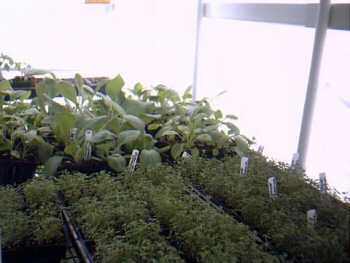
Not all light is the same, just ask any photographer. The light radiating through a greenhouse covering is important for plant growth. Not only does a greenhouse provide additional warmth, it must also create the correct amount and type of light. Plants grow optimally with 70-75% available light. More light beyond the optimal range is more likely to lead to overheating than more growth. Direct light is the light most easily viewed by our eyes. Direct light travels in beams until it is stopped by an object. That object is fully illuminated while the area around it is cast in shadow. Diffuse light is scattered light. It bends around corners and leaves no shadows. Photographers prefer overcast days to sunny days because the clouds scatter the light producing even lighting rather than hot spots and shadows. Plants, too, benefit from the scattering of the light rays and grow up to 30% faster when all leaves are bathed in light, not just the upper canopy of the plant.
Longevity - How long will the covering last?
Some coverings are designed to last for years without reduced performance. Others will last a season or two. In some areas with a mild climate, growers may be able to use film for several years before requiring replacement. That same film may last only until the first wind storm in other areas. If you live in an area with frequent storms, many trees or heavy snow, you will likely require a sturdy covering.
When considering the type of covering to use, it is a good idea to CHECK THE WARRANTY. The timeframe will give you a good indication of what to expect. It's also important to find out what the warranty covers and what repair options are available. In some cases, damage to a small portion of the greenhouse is easily repaired or replaced. REMEMBER: Some greenhouse kits are made to easily replace the covering while others kits are next to impossible.
Wear - How various greenhouse materials age
You'll want to consider how various materials age. Scratching, yellowing, significant darkening, and cracking are possible with age; all of which can impact performance. In some cases, the changes will be purely cosmetic. Some materials develop a rough surface with age; which then attracts mold, dirt and debris blocking the light to the extent that it no longer functions. UV resistance is the final factor to consider for wear. Greenhouses must withstand the harshest conditions possible and ideally are in direct sunlight most of the year. Only the toughest materials designed to take the UV rays will survive. It is important to determine if the covering you are choosing was designed for years of abuse. It is also important to find out if the material is scratched or damaged in some way, are the UV rays more likely to do damage.
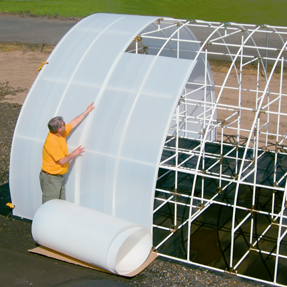
Ease of application
Ease of application is especially important if you are building a custom structure versus a kit or pre-made structure. Covering materials come in a wide variety of forms from a roll to sheet form. Some sheets are rigid while others have some flexibility. In building your own structure you will want to think about making custom cuts, about attaching the material to your frame and about the direction you plan to apply the material. Some materials install only vertically while it does not make any difference with others.
Cost/Value
Cost is an important factor in the decision making process, however, value is even more important. To determine value in each case it is important to consider your climate as well as how you will use the greenhouse. If your objective is to get a few weeks jump start on your planting, then you likely do not need to have an insulated covering which adds cost. If you would like to grow year-round, then invest in a covering that provides durability, insulation and light diffusion. It cannot be stressed enough to do your homework before making a major purchase of a greenhouse or greenhouse glazing.
In the last few years, the industry has seen a major decrease in quality offerings. As with most things, price is a constant pressure. Material costs increased significantly over the past several years. To compensate some manufacturers have taken short cuts with quality. At first glance, some of the greenhouses displayed recently at various industry trade shows looked reasonably nice for the price. Upon close inspection it was clear these structures would not last more than a season, if that. One greenhouse was covered with a double-wall polycarbonate, normally a rigid material, which was so flimsy it rolled like thick paper. The vendor across the aisle from their display reported the door fell off nearly every time someone walked passed.
Spending even $400 or $500 on an inexpensive greenhouse quickly becomes very costly if it's not quality. Aside from the time and labor involved, one windstorm could mean a total loss for the greenhouse and all the plants inside. Every time I see a product like this, I cringe at the thought of an unsuspecting consumer spending their hard-earned dollars on pure junk.
While I do not personally know of anyone selling these greenhouses, I'm sure they are out there. Some so-called greenhouses are horribly made, but there are far more reputable sellers who offer quality products than those that don't. The key to making sure you get quality and value is to ask questions and don't assume that something that looks good in a picture will deliver the results you want. Any reputable seller will be happy to answer your questions. They will understand your needs and help you select the product that will work best for your climate, your conditions and your desires.
What are the differences in greenhouse coverings?
There are many covering options. They range from double pane glass to single thickness film. Insulated glass is the most expensive and can easily cost upwards of $20per square foot. Firm is the least expensive running approximately $0.11 per square foot.
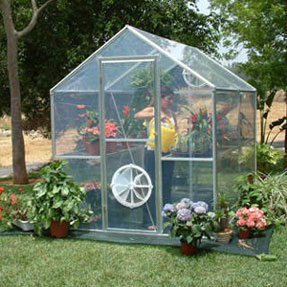
Single wall film
Film, thin plastic sheeting, is the most commonly used material among commercial growers. The large sheets stretch over a metal frame and attach with clips. The sheeting is inexpensive and provides light diffusion. Replacement can be a big job but commercial growers generally have the staff to provide the labor. Most of these greenhouses are not heated unless they are covered with two layers. This is referred to as "double poly" and is highly insulated because a fan constantly blows air between the two layers of plastic.
Pros: Inexpensive. Easy to ship and store. Provides good light diffusion. Keeps frost away.
Cons: Tears easily in wind. Will not withstand heavy snow. Offers insignificant insulation without blown air system. Is difficult to install in wind. Requires extra electricity to operate the fans.
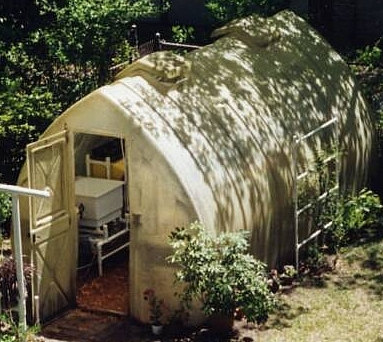
Fiberglass
Fiberglass was a common greenhouse material in years past. It is still used, but with much less frequency.
Pros: Good light diffusion when product is new. Extremely strong. Long lasting
Cons: Fibers shrink as material ages causing a rough surface which attracts particles. Looses significant light transmission with age. Yellows. Insignificant insulation
Single wall polycarbonate
Panel designs in recent years allow for a remarkably strong single wall panel. These panels are completely clear and do not diffuse any light. Resembling glass, they are attractive. Panels are typically sold as part of a greenhouse kit rather than for custom projects.
 Pros: Nice looking and surprisingly strong given the light weight. Works well as a large cold frame to keep frost at bay. Can extend season by a few weeks in spring and fall.
Pros: Nice looking and surprisingly strong given the light weight. Works well as a large cold frame to keep frost at bay. Can extend season by a few weeks in spring and fall.
Cons: No light diffusion so they get very hot and have significant shadows. Insignificant insulation. Surface scratches easily. Not sufficient for year-round use in most areas.
Single-wall Acrylic
This material is very similar to single wall polycarbonate. There are no distinguishable features other than acrylic tends to scratch more easily than polycarbonate. Acrylic is more readily available than single wall polycarbonate for DIY projects. Many places that sell it will cut the sheets to size.
Multi-wall polycarbonate
The most common form of multi-wall polycarbonate is double wall. This material has two layers of polycarbonate sheeting attached by a perpendicular support creating flutes. These flutes hold air, thus provide insulation. Surprisingly, larger flutes do increase insulation over small flutes, but only by a small margin. Once the air space is large enough air starts to circulate.
< 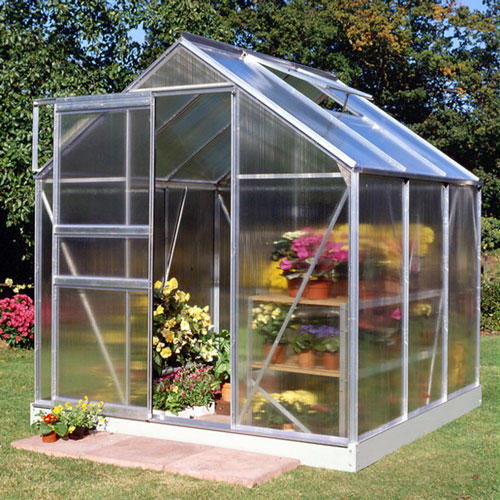 Much of the insulation properties are lost as air moves inside the flutes. The triple wall and quadruple wall materials sandwich more layers between the flutes. An 8m thick triple wall sheet of polycarbonate will offer more insulation than an 8mm thick double wall. Quality polycarbonate is extremely strong and will last for years in an outdoor application. It is not uncommon to find quality polycarbonate with a 20-year warranty. Polycarbonate is treated with a UV protective coating on one side of the material.
Much of the insulation properties are lost as air moves inside the flutes. The triple wall and quadruple wall materials sandwich more layers between the flutes. An 8m thick triple wall sheet of polycarbonate will offer more insulation than an 8mm thick double wall. Quality polycarbonate is extremely strong and will last for years in an outdoor application. It is not uncommon to find quality polycarbonate with a 20-year warranty. Polycarbonate is treated with a UV protective coating on one side of the material.
Pros: High quality material is long-lasting. Provides significantly more insulation than many materials on the market. Highly impact resistant. Will not yellow with age. Attractive, although not see-through like glass. Offers slight light diffusion.
Cons: One of the most expensive materials. Scratches easily. Difficult to cut. Expensive to ship. Must carefully select for quality.

Solexx
Solexx looks much like double-wall polycarbonate with a translucent tint. It is available in 3.5 mm and 5 mm thicknesses and comes in a variety of sizes. Solexx provides excellent light diffusion and is the most insulated covering ,making it easy to heat and cool. The material is flexible so it bends easily around corners and is easy to cut. Highly impact resistant. There are similar looking corrugated plastic products on the market, however, none are engineered for prolonged outdoor use.
Pros: Excellent light diffusion. No shadows. Best insulation, inexpensive to heat. Comparatively inexpensive to ship. Extremely durable and impact resistant. Costs less than polycarbonate. Made in the United States. Easy to cut and install.
Cons: Significantly more expensive than film. Cannot see plants in greenhouse from outside.

Glass
Often glass is the material of choice for its aesthetics. There is no material as beautiful as glass in a greenhouse. Most glass greenhouses have a shading mechanism or they are whitewashed with a combination of white latex paint and water. This coating is applied yearly and scraped off when the threat of overheating passes. Glass can be single or double pane. Single pane glass provides little to no insulation and can cause sweating in a winter greenhouse. Double pane glass offers significantly more insulation and protection, although it adds considerable expense. Reclaimed glass windows are an excellent option for a lower cost greenhouse, especially when used on end walls and along the bottom of the greenhouse rather than for the roof. Commercial glass greenhouses often employ complex computerized systems to open and close roof vents and to automatically manipulate shading when specific temperature thresholds are met.
Pros: Beauty. Long-Lasting. Excellent insulation with storm windows. Many windows available for little or no cost.
Cons: Require maintenance. Can generate extreme heat. No light diffusion. Breaking hazard.
Looking Forward Sometimes Requires Looking Back
Once again we are learning to appreciate home grown food and gardening in general. During World War II there was an explosion of gardening in the United States when growing a Victory Garden was a patriotic, and necessary, activity. Ironically, at the time we were discovering our gardens, the last remnants of the Crystal Palace were destroyed. Two large water towers, spared by the original fire, were removed at the start of the war. The British Government feared the towers would provide navigational aids to German bombers. That final destruction marked the end of an era, yet it can provide inspiration for facing the challenges ahead.
Not only is there tremendous opportunity to create a richer life by growing food, we can create more joy in our lives. Growing outside your zone means opening up an entirely new world of possibilities. It means improving on mother-nature and enjoying the beautiful sights and smells longer than we should be able. If you are thinking about starting a greenhouse, now is the time. What could be a better investment than assuring fresh food for your family right in your backyard? You don't need to have a perfect structure inspired by the Crystal Palace; you just need to be inspired to start. It's amazing what can be created with a little imagination and some research.
It's no secret we are facing tough times, but the way forward just may come from looking back. In times of adversity we've rising to incredible challenges through hard work and self-sufficiency. Those looking back to a time we pulled together as a nation by taking care of ourselves are likely to be the ones to lead us ahead to our next era of plenty. In the United States, we are just starting to explore the wonderful possibilities of growing in a greenhouse. It is likely some of the most promising technical advances in our life-times will happen in a greenhouse. To most fully enjoy some of those advances in your own yard, arm yourself with the facts and find a resource you can trust to help you along the way.
Questions to Explore Prior to Purchasing a Greenhouse or Greenhouse Glazing.
To determining the best options for your specific needs it is worthwhile to spend some time considering the following factors:
Budget
1. How much can you spend on a greenhouse?_________________
2. Will this be a one-time purchase you plan to keep for many years?____________
3. Do you prefer to start small and build the greenhouse in stages or improve it later? Y/N
Your Plans
1. What is the primary purpose of your greenhouse?______-Aesthetic/Function
2. What will you use your greenhouse for (list all possible and planned uses)?_______________________
3. How many months of the year do you plan to operate your greenhouse?______________
4. Do you plan to grow in the winter?__________ Y/N
5. Do you plan to grow in the summer? _________Y/N
6. What type of plants do you plan to grow? ___________Annuals/Flower Starts/Vegetables & Food/Perennials/Tropicals
7. Do you plan to start seeds? ___________Y/N
8. Do you plan to overwinter containers or plants in the greenhouse? _________Y/N
Your Climate
1. What is your coldest outdoor nighttime temperature?____________
2. What are your hottest daytime temperatures?_________________
3. How many days of sun do you have on average each year ?__________
4. Do you have high winds? _________Y/N
5. Do you have hail? ______Y/N
6. Do you have heavy snow loads? _______Y/N
Your Site:
1. How much sun do you get where you will place your greenhouse? _____Full/AM only/PM only/Partial Day/Shade
2. Do you have overhanging tree branches near your selected site? ____Y/N
3. If Yes to #2, do you anticipate any of the following? ____Pitch from overhead trees/Bird Droppings/Falling Branches/Other debris
4. Do you have access to Electricity? ____Y/N
5. Do you anticipate periods of heavy dust? ________Y/N
6. Do you intend to install a foundation? ______Y/N
7. How level is your site?__________
Additional Resources
Solexx Greenhouses - perfect diffused light for growing tomatoes
Solexx Greenhouse Covering - do it yourself (DIY) covering that is easy to work with and provides high insulation.
Grow Lights - grow light options to extend to daylight in the greenhouse
Contact our greenhouse experts at 1-800-825-1925 or email us at info@greenhousecatalog.com for help planning your greenhouse design.






